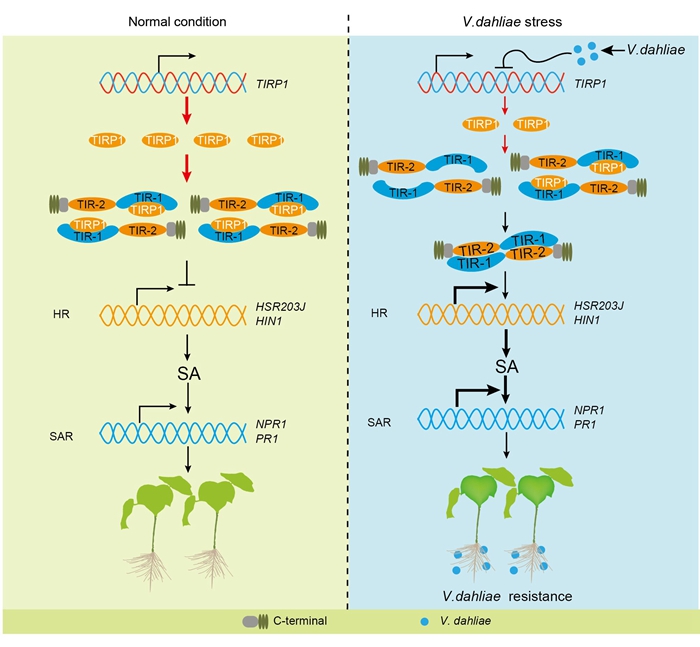- Location : Home» Newsroom
CAAS|Genome-wide association analysis reveals a novel pathway mediated by a dual-TIR domain protein for pathogen resistance in cotton
A team led by Professor Fuguang Li and Zhaoen Yang from the Institute of Cotton Research at the Chinese Academy of Agricultural Sciences (ICR, CAAS) has conducted research aimed at identifying and understanding excellent disease-resistant genes in cotton germplasm resources. Specifically, they uncovered a previously unknown introgressed fragmentin the Gossypium hirsutum genome that is associated with increased resistance to Verticillium wilt (VW), a soilborne fungal disease that is a significant threat to crops like cotton, tomatoes, peppers, and lettuce. They discovered GhRVD1 as one causal gene in the introgressed fragment,and also revealed a novel pathway of GhRVD1-GhTIRP1 regulating VW. These findings provide an important target for improving cotton disease resistance through biological breeding and offer a new approach to preventing and controlling VW in cotton. The team’s research has been published online in the journal Genome Biology under the title “Genome-wide association analysis reveals a novel pathway mediated by a dual-TIR domain protein for pathogen resistance in cotton”.
The study identified a locus introgressed from G. arboretum associated with enhanced resistance to Verticillium wilt and discovered that NBS family gene GhRVD1, is the key gene for resistance to Verticillium wilt. However, its disease resistance mediated by GhRVD1 is weakened by mutations at a few nucleotide sites in the G.hirsutum genome. Moreover, GhRVD1 is the first NLR protein identified in plants with a dual-TIR domain, and the dual-TIR domain mediates rapid immune response by forming reverse parallel dimers. In addition, the study revealed that GhTIRP1, physically interacted with of GhRVD1, is an important switch for balancing nutrition growth and immune responses within plants, and it competes with GhRVD1 under normal growth conditions, inhibiting dimer formation and thereby blocking its immune response to maintain normal cotton growth. Under conditions of invasion by Verticillium dahliae, however, it reduces its expression to release GhRVD1 from its binding, thereby promoting dimer formation and activating downstream immune responses to resist invasion by the pathogen.
Dr. Li Fuguang and Dr. Yang Zhaoen from the ICR are corresponding authors of the paper, and Zhang Yihao, a doctoral student, and Zhang Yaning, a master’s student, are co-first authors of the paper. Dr. Ge Xiaoyang participated in the study, and Dr. Wang Zhi provided guidance for the study. This work was supported by funding from the National Key Research and Development Program (2021YFF1000102-1), Natural Science Foundation of Henan (No.232300421010), Central Public-interest Scientific Institution Basal Research Fund (No. Y2023XK16), Innovation Program of the Chinese Academy of Agricultural Sciences (CAASASTIP-IVFCAAS), and the Fundamental Research Funds of State Key Laboratory of Cotton Biology (CB2021E03).
Link to the paper:https://doi.org/10.1186/s13059-023-02950-9

Figure 1 A working model for TIRP1 regulating self-association, auto activity, and VW resistance of dual-TIR domain protein in the plant
Original link:https://www.caas.cn/en/Newsroom/ResearchUpdate/a6c39e09bc904708b751a7262f177a71.htm